
the cornucopia
olympus ace interchangeable lens rangefinder camera
copyright the olympus circle/john foster

the cornucopia olympus ace interchangeable lens rangefinder camera copyright the olympus circle/john foster |

Olympus Ace and Lenses |
INTRODUCTION: This article about one rather special camera from the Olympus stable in the late 50's, the Olympus Ace, and appeared in Quest, the Magazine of The Olympus Circle, in March 2005 issue No 7. It examines in detail the Ace and its four interchangeable lenses and draws on further research done by the author and Olympus aficionado, John Foster. ~~~~~~~~~ In 1948 and about the same time as Nippon Kogaku KK announced their stunning Nikon 1 - a high quality rangefinder with interchangeable lens capability, Olympus was struggling with its first ‘35mm’ format fixed lens camera, the 35 model 2 or CatsPaw as it is now known. However, before berating Olympus too harshly we should remember the company produced an interchangeable lens rangefinder in the shape of the Olympus Standard in 1938. Had time not been so inconvenient perhaps Olympus would have beaten Nikon by a decade, but plans for the Standard were dropped as war loomed. We move to 1948 and the allied occupation was in force. The American administration in its wisdom decreed that the old Nippon format of 24mm x 32mm could only be sold for Japanese consumption; thus forcing all Japanese camera makers to adopt the standard 24mm x 36mm if they wished to tap the lucrative 35mm export market. Ten years further on in December 1958, Olympus produced the 35mm Ace camera, their interpretation of a 35mm interchangeable lens rangefinder camera which is, basically, a copy of the Nikon. So let us have a closer look at the Ace. The choice of name might give us a clue as to the target buyers - frustrated reporters or journalists perhaps? Ace reporter? Maybe! |
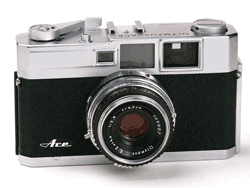
Ace with Standard 4.5cm x f=2.8 Lens |
Nothing in the hand book makes reference to what was indeed a brave foray by Olympus. Though the company had much experience of fixed lens and lens shutter cameras there had been no indication of any desire by Olympus to manufacture an interchangeable lens camera except perhaps the earlier 35 S 1.9 (1956) which had a detachable screw in lens that fitted flush to the shutter block (similar to Retina). To my knowledge, however, only one lens was ever marketed - the standard 45mm x 1.9 G Zuiko. Jean-Paul Francesch too was intrigued by this screw-in lens as he says in his book that no amount of research ‘has answered our question regarding any other screw-in lenses being available for the 35 S 1.9.’ Quite where the inspiration for the Olympus Ace originated is a mystery other than a bit of company plagiarism of Nikon rangefinders. The Ace is a nicely made and capable camera, but a Nikon it is not! Introduced in December 1958 priced at 17,800 Yen with standard lens, it remained in production until April 1961 (as the Ace E), amounting to some 29 months of continuous production. I have no figures on numbers made. At introduction 3 lenses were available, Standard being E Zuiko 45mm x 2.8; Wide being E Zuiko 35mm x 2.8, priced at 6,800 Yen and telephoto being E Zuiko 80mm x 5.6 priced at 7,800 Yen. A complete outfit cost 32,400 Yen, around £100.00 approaching a UK average monthly salary; not cheap by any standard. |
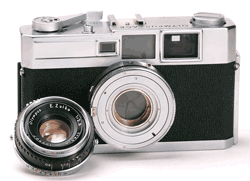
Ace with standard Lens detached |
The newly designed body was a departure from the previous 35 series rangefinders that have a square shutter mounting face-plate between top and bottom plate giving them an over-square, old fashioned look, which can be traced right back to the 35 CatsPaw. On the Ace the shutter block is mounted directly to the body giving a fresh look to the camera and setting a design standard that lasts into the 1980’s. The lens mount is a shutter sized three clawed bayonet that is locked in place by a spring latch (see left). |
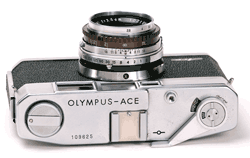
Ace with 3.5mm x f=2.8 E. Zuiko W Lens fitted |
The lens is dismounted by pressing the latch with the left thumb and turning the lens anticlockwise with the other hand about 90 degrees and lifting. The Ace features automatic coupling with the built-in rangefinder for all lenses and a triple bright frame viewfinder for the three focal lengths available. You will have noticed the illustration above shows 4 lenses. A second version of the 80mm telephoto was also made offering a faster lens of f=4.0 rather than f=5.6. (See final illustration below). There is no information available to tell us when this second version was made (though I suspect it was probably for the later Ace E). However, I chose to include it in the photo as it is an Ace lens by configuration. (And not for the first time in my collecting history I owned the lens before having either Ace camera and as it turns out the 80mm x f=4.0 is somewhat of a rarity). Here is the Ace with the ‘S’ or standard lens fitted. You can see the lens locking latch just above the synchro terminal on the left. Below is a top plate view of the Ace with the 35mm x 2.8 ‘W’ wide angle lens fitted. The Ace has a built in delayed action (red) and M and X synchronisation. Speeded 1~500th + B the leaf shutter will sync at all speeds. |
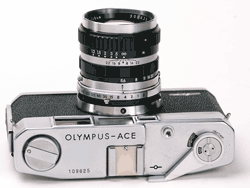
Ace with 80mm x f=5.6 telephoto Lens |
Here the Ace is seen with the 80mm x 5.6 telephoto fitted and in my eyes this is a very attractive union. I much prefer it to the chubby but faster f=4.0 second model. Below are the four lenses; you will notice that the telephotos’ have ‘T’ in red against a black spot that lines up with the lens latch and the wide and standard lenses have ‘W’ and ‘S’ engraved central to the DoF scale. Lenses come with their own plain front caps and uniquely styled back caps. Though they are interchangeable to do so is quite fiddly and it easy to turn them too hard resulting in possible damage to the femur claw of the bayonet. And of course when removed the shutter leaves are exposed to injury as no body cap is provided. |

The four detachable lenses, front; wide and standard, rear; both 80mm E Zuiko's |
I must admit to only having ever put one roll of film through the Ace. I was somewhat disappointed as the images were a little soft and seemed to lack that famous Zuiko contrast we are all now used to. That said the camera is easy enough to use; the triple ‘Golden Frame’ bright line finder is simplicity itself and parallax correction is inbuilt. As with all fully mechanical cameras it is essential to run the shutter quite often to stop it gumming up. Interestingly, the boxed lenses accompanying my Ace have two ‘Inspected’ rosettes, one from JCII and the other from JCIA. You will all know the reasoning behind the ‘inspected’ stickers - to act as an open standard for quality assurance after many years of criticism of poor quality Japanese goods. I believe there was some disagreement between the two inspectorate eventually leading to the JCIA being abandoned in favour of the more independent JCII which remains unto this day. Our Club Secretary, Terry Hardy, tells me this happened in 1959, thus nicely dating my Ace outfit. |
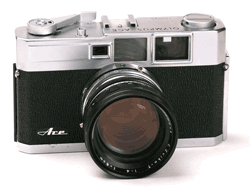
Ace body with 80mm x f=4.0 fast telephoto lens fitted |
The example illustrated numbered 109625 is in quite good aesthetic condition with typical plating issues on the top/bottom plates, but not too bad. Mechanically it is very sweet indeed with rangefinder, Copal SV shutter and timer all working and accurate, though the wind on is a little rough. The construction is typical of the late 50’s and of Olympus; the body made of die cast aluminium with ‘chrome’ plated top and bottom plates. Although Mr. Maitani was employed by Olympus at this time, he was in his apprenticeship and the Ace bears non of the Maitani design signatures. It is not known who designed the Ace camera. As said the Ace was replaced with the Ace E in December 1959, 12 months after being introduced. The Ace E is basically the same camera with the addition of a non-coupled exposure meter. Valuation: (My personal opinion based on many years of observation). Ace body + standard lens Quite Rare: Value: MiB £100, less so = £65 Ace Wide lens Quite Rare: Value: MiB £50, less so = £30 Ace Telephoto x 5.6 lens Quite Rare: Value: MiB £70, less so = £45 Ace Telephoto x 4.0 lens: Rare: Value: MiB = £100, less so £70 Ace ER Case £5 Thanks to John Foster, Editor, Quest (author) and the Executive Committe of The Olympus Circle in whom copyright vests. |
|
|
|
HOME |
INTRO |
BOOKS |
OLYMPUS CIRCLE |
QUEST |
TOC MEMBERS |
GALLERIES
|
| Posted 06/06/2005 | Copyright © 2005 John Foster |